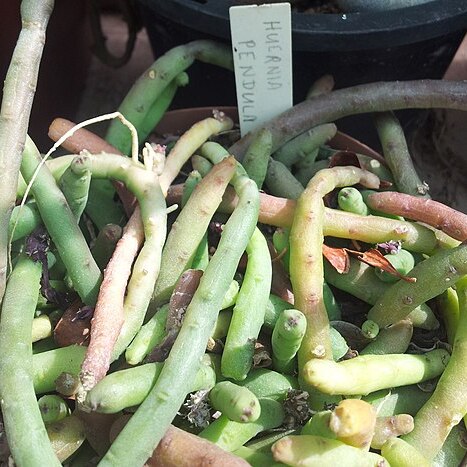Small succulent forming mats 150-500 mm diam. on ledges on cliffs with some pendent stems. Stems 150-500 mm (-1.5 m) long, 3-8 mm thick, trailing to pendent, if initially erect then soon arching back to ground and rooting, grey-green to green to purplish; tubercles very obscure so that stem ± cylindrical. Inflorescence of 1-5 flowers developing in gradual succession from gradually elongating peduncle (up to 20 mm long) with few deltoid to lanceolate bracts (<2 mm long), arising mainly towards base of stem but also along stem towards and at apex; pedicel 7-10 mm long, ±1.5 mm thick, descending and holding flower nodding or facing downwards, purplish; sepals 3-4 mm long, 1 mm broad at base, attenuate, purplish. Corolla 8-10 mm long, 15-26 mm diam., bowl-shaped; outside cream suffused with purple especially towards apices of lobes, with 5 raised longitudinal veins running down each lobe and onto tube; inside dark maroon covered (except in lower quarter of tube) densely with low cylindrical-to conical-obtuse papillae (reaching max. length in mouth of tube) each with minute apical spikelet; tube 6-8 mm deep, occupying most of flower, widening towards mouth; lobes 4-5 mm long, 5-12 mm broad at base, ascending to spreading-recurved, deltate. Corona ±3 mm tall, 2.5-4.5 mm broad, without basal stipe; outer lobes <1 mm long, at least partially laterally fused, with 10 obtuse lobules or nearly disc-like, spreading on base of tube but not fused to it, blackish maroon; inner lobes ±1.0 mm long, red around base becoming blackish maroon above, adpressed to backs of anthers and exceeding them, dorsiventrally flattened, tapering from broad obtuse dorsal gibbosity at base to obtuse bristly apex.
More
Perennial succulent. Stems pendent, sometimes basally erect but bent over and rooting where they touch the ground, 150-500(-1500) x 3-8 mm, ± cylindrical to obscurely 4-angled, glabrous, grey-green. Flowers 1-5; pedicels 7-10 mm long. Sepals 3-4 mm long. Corolla 15-26 mm in diam., bowl-shaped, dark maroon, densely papillate; lobes suberect to spreading, sometimes recurved. Corona dark maroon; outer lobes spreading to form a 3.0-3.5 mm in diam. crenate disc; inner lobes strap-shaped, ± 1.5 mm long, basally appressed to anthers, converging above and tapering to obtuse tuberculate apex.

